Improving your indoor air quality (IAQ) can boost decision making scores by over 100%. It's time to breathe new life into your workplace.
.png)
 Every time we breathe out, we emit carbon dioxide (CO₂). Offices often recycle air and don’t have working windows, therefore when an office is full of workers, the CO₂ levels rise extremely quickly, leading to drowsiness, poor decision making and low productivity.
Every time we breathe out, we emit carbon dioxide (CO₂). Offices often recycle air and don’t have working windows, therefore when an office is full of workers, the CO₂ levels rise extremely quickly, leading to drowsiness, poor decision making and low productivity.
.png)
 According to the World Health Organisation (WHO), indoor air pollution is responsible for 2.7% of the burden of disease globally. To put that figure into context, it means that 1.4 million people are dying each year because of illnesses caused by poor IAQ.
According to the World Health Organisation (WHO), indoor air pollution is responsible for 2.7% of the burden of disease globally. To put that figure into context, it means that 1.4 million people are dying each year because of illnesses caused by poor IAQ.
.png)
 More and more buildings are sealed airtight to meet environmental targets. Many ventilation systems recycle air to conserve energy. This results in high CO₂ concentrations and poor IAQ, which have been directly correlated to low productivity, high sick leave and infectious disease transmission.
More and more buildings are sealed airtight to meet environmental targets. Many ventilation systems recycle air to conserve energy. This results in high CO₂ concentrations and poor IAQ, which have been directly correlated to low productivity, high sick leave and infectious disease transmission.
.png)
 VOCs originate from cleaning agents, solvents, air fresheners, candles and are even emitted by humans. When you have an enclosed space like a restroom, these emitted gases accumulate and pollute the air we breathe.
VOCs originate from cleaning agents, solvents, air fresheners, candles and are even emitted by humans. When you have an enclosed space like a restroom, these emitted gases accumulate and pollute the air we breathe.
.png)
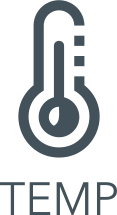 Kitchens can get very hot, and excess heat affects cognitive ability. For every one degree Fahrenheit increase above average temperature, there is a corresponding performance drop of 1%.
Kitchens can get very hot, and excess heat affects cognitive ability. For every one degree Fahrenheit increase above average temperature, there is a corresponding performance drop of 1%.
.png)
 VOCs can cause short-term problems like headaches and inflammation of eyes, nose or throat, as well as contributing to longer-term conditions like cardiovascular disease, asthma, lung cancer, and impact on reproductive systems.
VOCs can cause short-term problems like headaches and inflammation of eyes, nose or throat, as well as contributing to longer-term conditions like cardiovascular disease, asthma, lung cancer, and impact on reproductive systems.

.png)
 Every time we breathe out, we emit carbon dioxide (CO₂). When a classroom is full of active students, the CO₂ levels rise extremely quickly, which can lead to drowsiness, poor decision making, low concentration spans and low productivity.
Every time we breathe out, we emit carbon dioxide (CO₂). When a classroom is full of active students, the CO₂ levels rise extremely quickly, which can lead to drowsiness, poor decision making, low concentration spans and low productivity.
.png)
 More and more buildings are sealed airtight to meet environmental targets. Many ventilation systems recycle air to conserve energy. This results in high CO₂ concentrations and poor IAQ, which have been directly correlated to low productivity, high sick leave and infectious disease transmission.
More and more buildings are sealed airtight to meet environmental targets. Many ventilation systems recycle air to conserve energy. This results in high CO₂ concentrations and poor IAQ, which have been directly correlated to low productivity, high sick leave and infectious disease transmission.
.png)
 According to the World Health Organisation (WHO), indoor air pollution is responsible for 2.7% of the burden of disease globally. To put that figure into context, it means that 1.4 million people are dying each year because of illnesses caused by poor IAQ.
According to the World Health Organisation (WHO), indoor air pollution is responsible for 2.7% of the burden of disease globally. To put that figure into context, it means that 1.4 million people are dying each year because of illnesses caused by poor IAQ.
.png)
 Computer rooms can get very hot, and higher temperatures affect cognitive ability. For every one degree Fahrenheit increase above average temperature, there is a corresponding performance drop of 1%. At higher temperatures, students’ learning capacity is negatively affected.
Computer rooms can get very hot, and higher temperatures affect cognitive ability. For every one degree Fahrenheit increase above average temperature, there is a corresponding performance drop of 1%. At higher temperatures, students’ learning capacity is negatively affected.
.png)
 VOCs cause short-term problems like headaches and inflammation of eyes, nose or throat, as well as contributing to longer-term conditions like cardiovascular disease, asthma, lung cancer, and impact on fertility.
VOCs cause short-term problems like headaches and inflammation of eyes, nose or throat, as well as contributing to longer-term conditions like cardiovascular disease, asthma, lung cancer, and impact on fertility.

Improving your indoor air quality (IAQ) can boost decision making scores by over 100%. It's time to breathe new life into your workplace.





Improving your indoor air quality (IAQ) can boost decision making scores by over 100%. It's time to breathe new life into your workplace.





Get an overview of all rooms, floors and locations. Receive automated alerts should conditions change and air quality deteriorate.
.png)
Dig deeper into your data to observe trends, compare current values with past measurements, and identify incidents that correspond with activities.
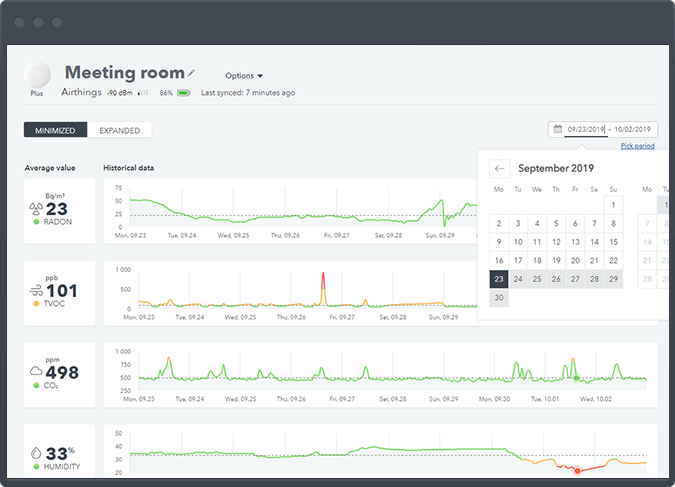
Add and remove tiles to customize your dashboard to your preference. If the account is shared, tailored preferences can also be set per user.
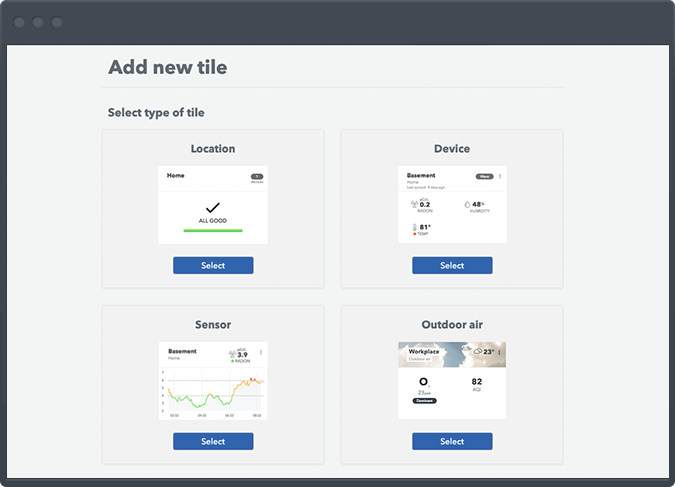
Use occupancy patterns to determine the optimal times for operating your building’s ventilation system, appease indoor climate complaints with live data or confirm when action is needed.
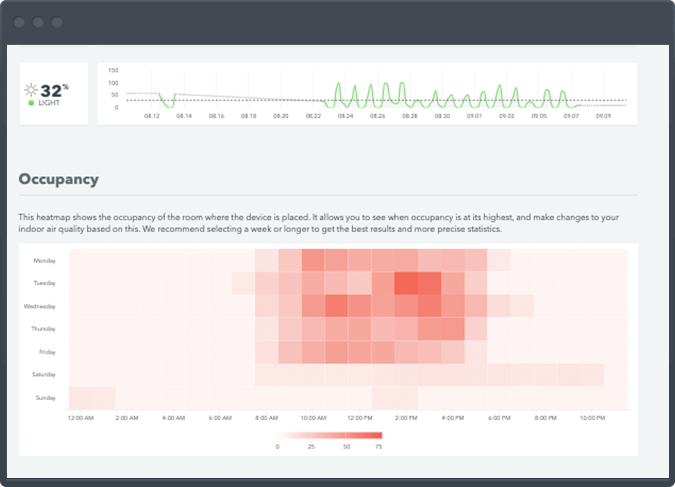
Generate custom radon or IAQ reports to share with your business or export data as a CSV file for further analysis. Ideal if you need to demonstrate proof to enable action.
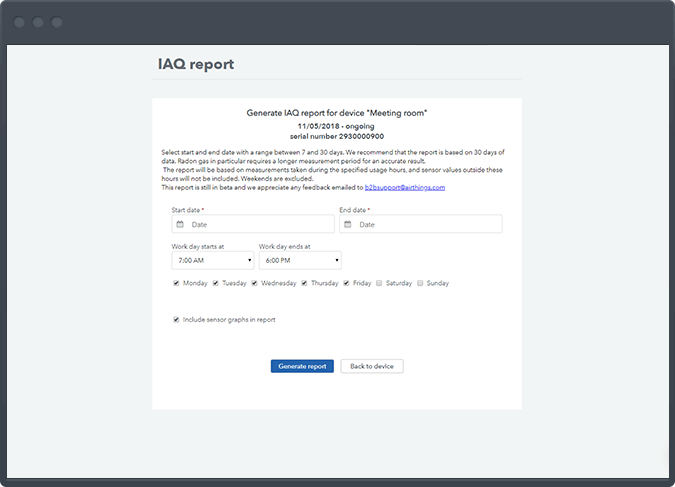
As the need to save money, improve efficiencies, and provide an improved indoor environment continues to trouble businesses, many decision makers are turning to IAQ monitors for help.
Leveraging IAQ sensor data empowers individuals with actionable insights, enables data-driven decision making and provides employers with compelling evidence when it comes to employee complaints regarding indoor climate.

Know when air quality is poor and take steps to remain active and alert.

Work to your full potential every day, by removing pollutants that impact your decision making capabilities.

Deliver a solution that is proven to improve IAQ and reduce radon exposure.
The Airthings HBS Wave Plus device samples air every 5 minutes. In order to save battery, the device sleeps for 5 minutes and wakes up again to send a sample package to the HBS Hub.
2 x AA Lithium batteries provide an estimated 2 year battery life for the HBS Wave Plus.
Yes. The Airthings REST API or Webhook offers a secure and straightforward method for pulling sensor and device information into your own system.
Yes. The Airthings API contains all commands and information needed to pull sensor and device information into your existing BI solution or as an input into your BAS or BMS.
Yes. The Airthings Pro Dashboard contains an IAQ reporting feature, allowing you to export to PDF and share your IAQ data in a professional, yet easy to understand method.
No, Airthings sensors are factory calibrated and self-calibrate during use. The drift is within our stated measurement margin of error.
The range depends on the building, but we use low frequency radio which has a very long range and can penetrate thick walls. As a guide, a Hub’s range can reach 1-2 floors up and down, and go through roughly 10 light non-load bearing walls per floor.
No. The Airthings Healthy Building Solution is specifically designed to be a plug and play, wireless, battery operated solution. Magnetic mounting brackets and screws or 3M Command Strips make installation effortless.